Intel Architecture Day 2021: Alder Lake, Golden Cove, and Gracemont Detailed
by Dr. Ian Cutress & Andrei Frumusanu on August 19, 2021 9:00 AM ESTGracemont Microarchitecture (E-Core) Examined
The smaller core as part of Intel’s hybrid Alder Lake design is called an E-core, and is built on the Gracemont microarchitecture. It forms part of Intel’s Atom family of processors, and is a significant microarchitectural jump over the previous Atom core design called Tremont.
- 2008: Bonnell
- 2011: Saltwell
- 2013: Silvermont
- 2015: Airmont
- 2016: Goldmont
- 2017: Goldmont Plus
- 2020: Tremont
- 2021: Gracemont
Based on Intel’s diagrams, the company is pitching that the size of its Golden Cove core means that in the space it would normally fit one of its P-core designs, it can enable a four core cluster of E-cores along with a shared 4MB L2 cache between them.
For performance, Intel has some pretty wild claims. It splits them up into single thread and multi-thread comparisons using SPECrate2017_int.
When comparing 1C1T of Gracemont against 1C1T of Skylake, Intel’s numbers suggest:
- +40% performance at iso-power (using a middling frequency)
- 40% less power* at iso-performance (peak Skylake performance)
*'<40%' is now stood to mean 'below 40 power'
When comparing 4C4T of Gracemont against 2C4T of Skylake, Intel’s numbers suggest:
- +80% performance peak vs peak
- 80% less power at iso performance)peak Skylake performance
We pushed the two Intel slides together to show how they presented this data.
By these graphics it looks like that for peak single thread, we should see around +8% better than Skylake performance while consuming just over half the power – look for Cinebench R20 scores for one Gracemont thread around 478 then (Skylake 6700K scored 443). With +8% for single thread in mind, the +80% in MT comparing 4 cores of Gracemont to two fully loaded Skylake cores seems a little low – we’ve got double the physical cores with Gracemont compared to Skylake here. But there’s likely some additional performance regression with the cache structure on the new Atom core, which we’ll get to later on this page.
These claims are substantial. Intel hasn’t compared the new Atom core generation on generation, because it felt that having AVX2 support would put the new Atom at a significant advantage. But what Intel is saying with these graphs is that we should expect better-than Skylake performance at much less power. We saw Skylake processors up to 28 cores in HEDT – it makes me wonder if Intel might not enable its new Atom core for that market. If that’s the case, where is our 64-core Atom version for HEDT? I’ll take one.
Front End
The big item about the Tremont front end of the core was the move to dual three-wide decode paths, enabling two concurrent streams of decode that could support 3 per cycle. That still remains in Gracemont, but is backed by a double-size 64 KB L1 Instruction cache. This ties into the branch predictor which enables prefetchers at all cache levels, along with a 5000-entry branch target cache which Intel says in improved over the previous generation.
Back on the decoder, Intel supports on-demand decode which stores a history of previous decodes in the instruction cache and if recent misses are recalled at the decode stage, the on-demand stream will pull directly from the instruction cache instead, saving time – if the prefetch/decode works, the content in the instruction cache is updated, however if it is doing poorly then the scope is ‘re-enabled for general fetches’ to get a better understanding of the instruction flow. This almost sounds like a micro-op cache without having a physical cache, but is more to do about instruction streaming. Either way, the decoders can push up to six uops into the second half of the front end.
For Gracemont, the reorder buffer size has increased from 208 in Tremont to 256, which is important aspect given that Gracemont now has a total of 17 (!) execution ports, compared to eight in Tremont. This is also significantly wider than the execution capabilities of Golden Cove's 12 ports, related to the disaggregated integer and FP/vector pipeline design. However, despite that width, the allocation stage feeding into the reservation stations can only process five instructions per cycle. On the return path, each core can retire eight instructions per cycle.
Back End
So it’s a bit insane to have 17 execution ports here. There are a lot of repeated units as well, which means that Gracemont is expecting to see repeated instruction use and requires the parallelism to do more per cycle and then perhaps sit idle waiting for the next instructions to come down the pipe. Overall we have
- 4 Integer ALUs (ALU/Shift), two of which can do MUL/DIV
- 4 Address Generator Units, 2 Load + 2 Store
- 2 Branch Ports
- 2 Extra Integer Store ports
- 2 Floating Point/Vector store ports
- 3 Floating Point/Vector ALUs: 3x ALUs, 2x AES/FMUL/FADD, 1x SHA/IMUL/FDIV
It will be interesting to see exactly how many of these can be accessed simultaneously. In previous core designs a lot of this functionality would be enabled though the same port – even Alder Lake’s P-core only has 12 execution ports, with some ports doing double duty on Vector and Integer workloads. In the P-core there is a single scheduler for both types of workloads, whereas in the E-core there are two separate schedulers, which is more akin to what we see on non-x86 core designs. It’s a tradeoff in complexity and ease-of-use.
The back-end is support by a 32 KiB L1-Data cache, which supports a 3-cycle pointer chasing latency and 64 outstanding cache misses. There are two load and two store ports, which means 2x16 byte loads and 2 x 16 byte stores to the L1-D.
There is also has a shared 4 MB L2 cache across all four E-cores in a cluster with 17-cycle latency. The shared L2 cache can support 64 bytes per cycle read/write per core, which Intel states is sufficient for all four cores. The new L2 supports up to 64 outstanding misses to the deeper memory subsystem – which seems fair, but has to be shared amongst the 4 cores.
Intel states that it has a Resource Director that will arbitrate cache accesses between the four cores in a cluster to ensure fairness, confirming that Intel are building these E-cores in for multi-threaded performance rather than latency sensitive scenarios where one thread might have priority.
Other Highlights
As the first Atom core to have AVX2 enabled, there are two vector ports that support FMUL and FADD (port 20 and port 21), which means that we should expect peak performance compared to previous Atoms to be substantial. The addition of VNNI-INT8 over the AVX unit means that Intel wants these E-cores to enable situations where high inference throughput is needed, such as perhaps video analysis.
Intel was keen to point out that Gracemont has all of its latest security features including Control Flow Enhancement Technology (CET), and virtualization redirects under its VT-rp feature.
Overall, Intel stated that the E-cores are tuned for voltage more than anything else (such as performance, area). This means that the E-cores are set to use a lot less power, which may help in mobile scenarios. But as mentioned before on the first page, it will depend on how much power the ring has to consume in that environment - it should be worth noting that each four core Atom cluster only has a single stop on the full ring in Alder Lake, which Intel says should not cause congestion but it is a possibility – if each core is fully loaded, there is only 512 KB of L2 cache per core before making the jump to main memory, which indicates that in a fully loaded scenario, that might be a bottleneck.


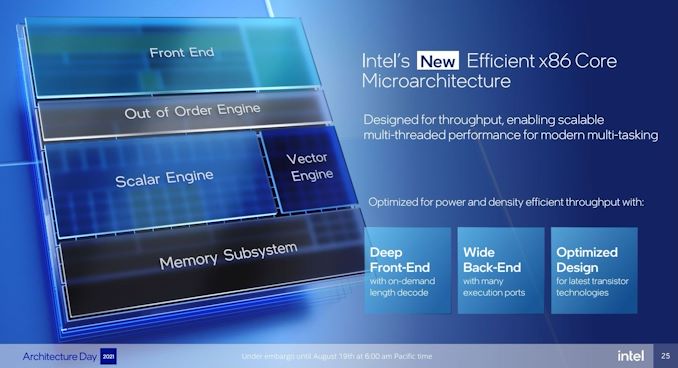
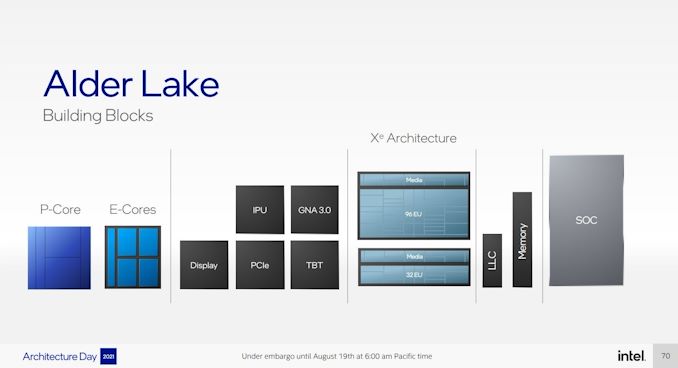

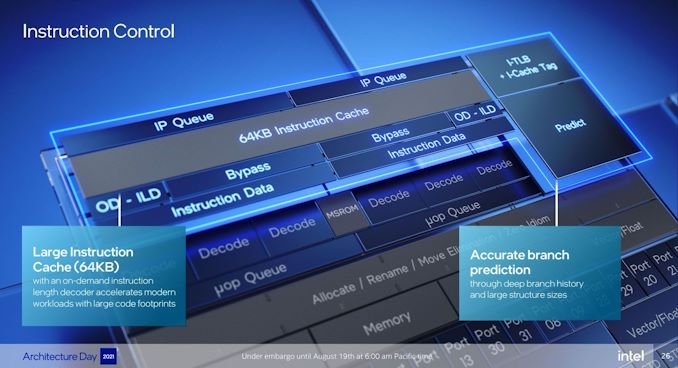
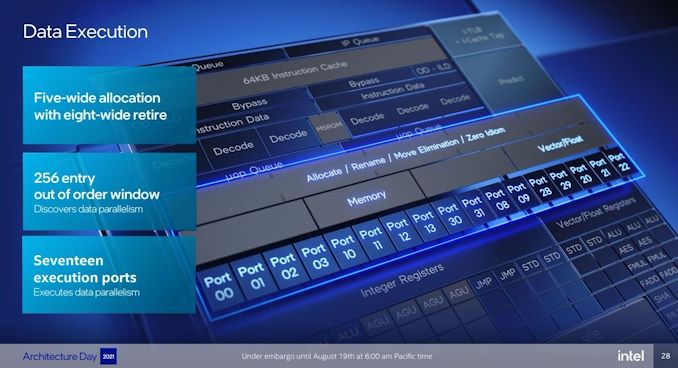
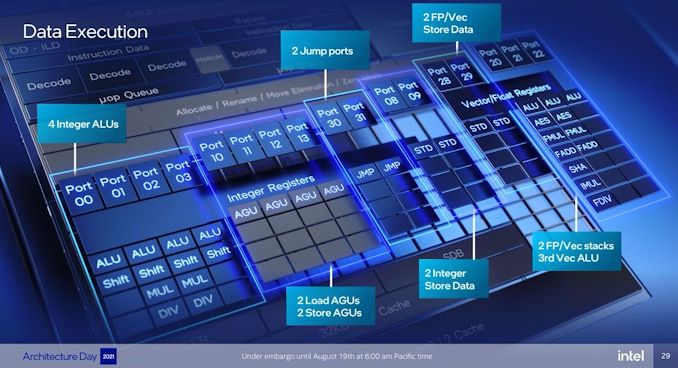









223 Comments
View All Comments
GreenReaper - Friday, August 20, 2021 - link
Intel Threat Detected!ifThenError - Friday, August 20, 2021 - link
LOL!Underrated comment
mode_13h - Saturday, August 21, 2021 - link
:Ddiediealldie - Thursday, August 19, 2021 - link
I'm quite curious how their E-cores are designed. They somehow use 6-way decoder which is same width compared to P-cores. And use twice bigger I-cache, yet using 1/4 of area.Maybe it's related to design philosophy? or Atom team's a true trump card of the Intel design team?
name99 - Thursday, August 19, 2021 - link
That "6-way decoder" is typical Intel double-talk. What is done is that you have two decoders that can each decode three instructions. This works IF there is a branch between the two sets of instructions, because the branch landing point provides a resync point for the second decoder, so the two can run in parallel.You could obviously extend this, in a decent Next Fetch Predictor system, to have the NFP store the lengths of each instruction in the run of instructions to be decoded, and get trivial parallel decode. And Andy Glew (I think it was him, either him or Jim K) submitted a patent for this around 2000. But in true Intel fashion, nothing seems to have been done with the idea...
GeoffreyA - Saturday, August 21, 2021 - link
If I'm not mistaken, Tremont or Goldmont, can't remember which, began marking the instruction boundaries in cache.name99 - Saturday, August 21, 2021 - link
Doing it in the cache is more difficult. Of course it makes the most sense! But it hits the problem that, *in theory*, you can have stupid code that jumps into the middle of an instruction and starts decoding the alternative version of the byte stream that results.This is, of course, absolutely insane, but it's part of the joy that is supporting x86.
Now one way to handle this is to tag the boundaries not in the I-cache (where you can jump to any byte) but in structures that are already set up to deal with instruction streams (as opposed to byte streams). Hence the Next Fetch Predictor, as I described, or in a trace cache if you are using that.
Another solution would be yet another predictor! Assume most code will be sane, but have a separate pool of decoders that are validating the byte stream as opposed to the high-speed instruction stream going through main path of the CPU. In the event of a mismatch
- treat it like a branch misprediction, flush and restart AND
- train the predictor that for this particular cache line, we have to decode slowly and surely
Now why doesn't Intel do any of these things? You and I can think of them, just as people like Andy Glew were thinking of variants of them 20 years ago.
My primary hypothesis is that Intel has become locked into the idea that GHz is everything. Sure they occasionally say they don't believe this, or even claim to have reformed after a disaster (*cough* Pentium4 *cough*) but then they head right back to the crack house.
I suspect it's something like the same mentality as the US Air Force -- when pilots form the highest levels of command, they see pilots as the essence of what the Air Force IS; drones and UAV's are a cute distraction but will never be the real thing.
Similarly, if you see GHz as the essence of what Intel is, that smarts are cute but real men work on GHz, then you will always be sacrificing smarts if they might cut into GHz. But GHz costs the problems we see in the big cores: the crazy power draws, and the ridiculously low density...
Well, this is getting into opinion, not technology, so interpret it as you wish!
GeoffreyA - Sunday, August 22, 2021 - link
Looking at the article again, I see their on-demand instruction length decoder is where this is happening. Seems to be caching lengths after they're worked out. I also wonder if this is why Atom hasn't had a uop cache as yet. It's either that or the length caching, because the uop cache will indirectly serve that purpose as well (decoded instructions don't need their lengths worked out). So it's perhaps a matter of die area here that Intel chose that instead of a uop cache.GeoffreyA - Sunday, August 22, 2021 - link
It's been said that K7 to Bulldozer also did a similar thing, marking instruction boundaries in the cache. And the Pentium MMX, but need to double check this one.mode_13h - Sunday, August 22, 2021 - link
> In the event of a mismatch - treat it like a branch misprediction, flush and restartYes, because even assembly language doesn't make it easy to jump into the middle of another instruction. IMO, any code which does that *deserves* to run slowly, so that it will get replaced with newer software that's written in an actual programming language.
> My primary hypothesis is that Intel has become locked into the idea that GHz is everything.
I think they just got lulled into thinking it was enough to deliver modest generational gains. Anything more ambitious probably jeopardized the schedule or risked their profit margins due to the cores getting to big and expensive. And when time comes for more performance, they reach into their old playbook and go with a "sure" win, like wider vectors. I wonder if the example of TSX reveals anything about their execution, on the more innovative stuff. Because that doesn't build a lot of confidence for taking on bold, new ideas.
> when pilots form the highest levels of command,
> they see pilots as the essence of what the Air Force IS
Not just pilots, but specifically fighter pilots. So, they also don't care much about bombers or Space Command (now Space Force). The only way to change that would be to make them care, by making them more accountable for the other programs, until they realize they need them to be run by someone who know about that stuff. Either that or just reorg the whole military. That would probably also help reign in defense spending.